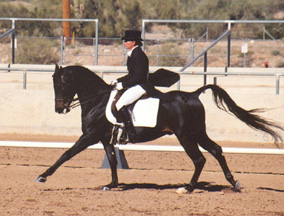
Bint Al Bahr Arabians
Preservation Breeders of Straight Babson Egyptians
 |
Bint Al Bahr Arabians Preservation Breeders of Straight Babson Egyptians |
![]()
Photo Tips - Page 8
Under Saddle Shots
Remind
the rider that they always have to have their “ears up” and you will be
watching the horse’s expression and leg movements not theirs. Talking while
riding will give them funny faces but a too serious face will make riding that
horse look like a lot of work. The
impression you want the rider to make is that they are enjoying a relaxed fun
ride. You might go over what they
plan to wear before the photo day so you can
co-ordinate the saddle blanket color, horse color and the riders outfit color to
create a more harmonious effect. The
horse should be the center of attention in the photo not the florescent lime
green shirt of the rider vibrating with the hot pink saddle pad.
 As for what
poses to strive for capturing, study magazine photos.
Note which foreleg is in front, the close one or the off leg.
Look at what that does for the hindquarters.
If that photo shows the effect you want, watch your horses legs and time
your shutter to click just before that foreleg reaches that point.
This is where it can be tricky with autofocus.
Autofocus will vary its response time to the shutter depending on light
and distance on every photo. If you
have a manual focus option this might be a good time to use it.
Since the horse is traveling a set path parallel to you, focus should not
be a problem once you manually set it. This
leaves you free to concentrate on the leg action.
Take your photo just a fraction before you think you will need to, if you
wait until the leg is where you want it, you are too late and will have missed
the shot. If your camera allows you
to do rapid succession (burst mode) shots you can try that feature hoping one will have the legs just
right.
As for what
poses to strive for capturing, study magazine photos.
Note which foreleg is in front, the close one or the off leg.
Look at what that does for the hindquarters.
If that photo shows the effect you want, watch your horses legs and time
your shutter to click just before that foreleg reaches that point.
This is where it can be tricky with autofocus.
Autofocus will vary its response time to the shutter depending on light
and distance on every photo. If you
have a manual focus option this might be a good time to use it.
Since the horse is traveling a set path parallel to you, focus should not
be a problem once you manually set it. This
leaves you free to concentrate on the leg action.
Take your photo just a fraction before you think you will need to, if you
wait until the leg is where you want it, you are too late and will have missed
the shot. If your camera allows you
to do rapid succession (burst mode) shots you can try that feature hoping one will have the legs just
right.
At
Liberty
 Most of what is
applicable for under saddle also goes for at liberty shots.
What changes is the predictability of the path the horse is going to
travel. With no rider to guide it
the horse will turn, take a path too close to you or too far from you and add
other variables with the lighting that are difficult to deal with.
For liberty shots a couple of helpers are needed to keep the horse moving in a
confined area. Plan on using twice
the film you would for under saddle. You still have to deal with the same
background problems, as well as lighting and have added a fence to the photo
area that must be presentable and something you want people to see as
representative of your farm. Make
sure that the fence is in good repair because your very best photo will be in
front of the only broken board or an obvious patch that will distract from the
beauty of the horse.
Most of what is
applicable for under saddle also goes for at liberty shots.
What changes is the predictability of the path the horse is going to
travel. With no rider to guide it
the horse will turn, take a path too close to you or too far from you and add
other variables with the lighting that are difficult to deal with.
For liberty shots a couple of helpers are needed to keep the horse moving in a
confined area. Plan on using twice
the film you would for under saddle. You still have to deal with the same
background problems, as well as lighting and have added a fence to the photo
area that must be presentable and something you want people to see as
representative of your farm. Make
sure that the fence is in good repair because your very best photo will be in
front of the only broken board or an obvious patch that will distract from the
beauty of the horse.
Your
cursor on the photos will tell you more about the photo and the horse.
![]()